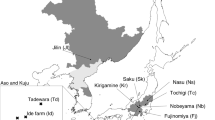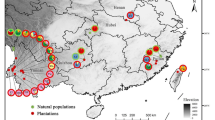Abstract
Sedum ussuriense Kom. (Crassulaceae) is a succulent perennial herb localized to rocky valleys in southeastern Korea. Although it is an important natural resource with high economic value as an ornamental plant, it is currently endangered because of land-use changes and illegal exploitation. To initiate a proper conservation plan, we selected four populations (Juwang, Okgye, Jeolgol, and Haok) around Mt. Juwang, characterized their phenotypic traits, and evaluated patterns of random amplified polymorphic DNA variation. Despite its small population size, Okgye had the greatest proportion of flowering plants and higher seed production than from the other populations. This population also harbored the greatest genetic diversity. However, recent fragmentation between Okgye and Haok appeared to cause genetic divergence, leading to close genetic relationships of Okgye to Juwang vs. Haok to Jeolgol. In the long term, this raises concerns about the loss of genetic variation and the possibility of a demographic crash in those fragmented populations. Because our results indicated a high degree of divergence among populations, we suggest that conservation activities should focus on maintaining and propagating all populations throughout this species’ range.



Similar content being viewed by others
References
Ayres DR, Ryan FJ (1999) Genetic diversity and structure of the narrow endemic Wyethia reticulata and its congener W. Bolanderi (Asteraceae) using RAPD and allozyme techniques. Am J Bot 86:344–353
Barrett SCH, Kohn JS (1991) Genetic and evolutionary consequences of small population size in plants: implications for conservation. In: Falk DA, Holsinger KE (eds) Genetics and conservation of rare plants. Oxford University Press, New York, pp 3–30
Bonin A, Ehrich D, Manel S (2007) Statistical analysis of amplified fragment length polymorphism data: a toolbox for molecular ecologists and evolutionists. Mol Ecol 16:3737–3758
Charlesworth D, Charlesworth B (1995) Quantitative genetics in plants: the effect of the breeding system on genetic variability. Evolution 49:911–920
Coates DJ (1988) Genetic diversity and population genetic structure in the rare chittering grass wattle, Acacia anomala Court. Aust J Bot 36:273–286
Dice LR (1945) Measures of the amount of ecological association between species. Ecology 26:297–302
Ellstrand NC, Elam DR (1993) Population genetic consequences of small population size: implications for plant conservation. Annu Rev Ecol Syst 24:217–242
Felsenstein J (2005) PHYLIP (Phylogeny Inference Package) version 3.6. Distributed by the author. Department of Genome Sciences, University of Washington, Seattle
Gitzendanner MA, Soltis PM (2000) Patterns of genetic variation in rare and widespread plant congeners. Am J Bot 87:783–792
Haig SM (1998) Molecular contributions to conservation. Ecology 79:413–425
Hamrick JL, Godt MJW (1996) Effects of life history traits on genetic diversity in plant species. Philos Trans R Soc Lond B 351:1291–1298
Hamrick JL, Godt MJW, Murawski DA, Loveless MD (1991) Correlations between species traits and allozyme diversity: implications for conservation biology. In: Falk DA, Holsinger KE (eds) Genetics and conservation of rare plants. Oxford University Press, New York, pp 75–86
Hedrick PW, Kalinowski ST (2000) Inbreeding depression in conservation biology. Annu Rev Ecol Syst 31:139–162
Holsinger KE, Gottlieb LD (1991) Conservation of rare and endangered plants: principles and prospects. In: Falk DA, Holsinger KE (eds) Genetics and conservation of rare plants. Oxford University Press, New York, pp 195–208
Hyun JO (2001) Categorization of the threatened plant species in Korea. Ph. D. thesis. Soonchunhyang University, Asan, Korea
Jeong JH (1999a) The distribution, growth environmental conditions, and morphological characteristics of Korean native Sedum rotundifolium at native habitats. Kor J Hort Sci 17:500–502
Jeong JH (1999b) Growth and flowering response of potted Sedum rotundifolium to low temperature, photoperiod and GA3. J Kor Soc Hort Sci 40:761–764
Jeong JH (2000) Effects of pinching and growth regulators on growth and flowering of Sedum rotundifolium. J Kor Soc Hort Sci 41:105–108
Jeong JH, Kwon ST (2003a) Induction daylength period for flower bud formation and development of Sedum rotundifolium. J Kor Flower Res Soc 11:225–228
Jeong JH, Kwon ST (2003b) Night break action on growth and flowering and photoperiod on adventitious bud formation of Sedum rotundifolium. J Kor Flower Res Soc 11:219–223
Kim CH, Kim TJ, Sun B-Y (2000) Taxonomic identities of some endemic Korean vascular plants. Kor J Plant Tax 30:355–361
Kwon ST, Jeong JH (1999) Genetic relationship among Sedum species based on morphological characteristics and RAPD analysis. Kor J Hort Sci Technol 17:489–493
Leimu R, Mutikainen P, Koricheva J, Fischer M (2006) How general are positive relationships between plant population size, fitness and genetic variation? J Ecol 94:942–952
Lynch M (1991) The genetic interpretation of inbreeding depression and outbreeding depression. Evolution 45:622–629
Lynch M, Milligan BG (1994) Analysis of population genetic structure with RAPD markers. Mol Ecol 3:91–99
Matthies D, Bräuer I, Maibom W, Tscharntke T (2004) Population size and the risk of local extinction: empirical evidence from rare plants. Oikos 105:481–488
Milligan BG, Leebens-Mack J, Strand AE (1994) Conservation genetics: beyond the maintenance of marker diversity. Mol Ecol 3:423–435
Ministry of Environment (2005) Wildlife protection act. Ministry of Environment, Gwacheon
Nybom H, Bartish IV (2000) Effects of life history traits and sampling strategies on genetic diversity estimates obtained with RAPD markers in plants. Perspect Plant Ecol Evol Syst 3:93–114
Page RDM (1996) TREEVIEW: an application to display phylogenetic trees on personal computers. Comput Appl Biosci 12:357–358
Peakall R, Smouse PE (2006) GENALEX 6: genetic analysis in excel. Population genetic software for teaching and research. Mol Ecol Notes 6:288–295
Reed DH (2005) Relationship between population size and fitness. Conserv Biol 19:563–568
Rossetto M, Weaver PK, Dixon KW (1995) Use of RAPD analysis in devising conservation strategies for the rare and endangered Grevillea scapigera (Proteaceae). Mol Ecol 4:357–364
Schaal BA, O’Kane SL, Rogstad SH (1991) DNA variation in plant populations. Trends Ecol Evol 6:329–333
Schlüter PM, Harris SA (2006) Analysis of multilocus fingerprinting data sets containing missing data. Mol Ecol Notes 6:569–572
Templeton AR (1986) Coadaptation and outbreeding depression. In: Soulé ME (ed) Conservation biology: the science of scarcity and diversity. Sinauer Associates, Sunderland, pp 105–116
UNEP (1995) Global biodiversity assessment, United Nations Environment Programme. Cambridge University Press, Cambridge
Young A, Boyle T, Brown T (1996) The population genetic consequences of habitat fragmentation for plants. Trends Ecol Evol 11:413–418
Acknowledgments
This work was supported by the National Institute of Environmental Research, Republic of Korea.
Author information
Authors and Affiliations
Corresponding authors
Rights and permissions
About this article
Cite this article
Ku, YB., Oh, H.K., Chun, Y.J. et al. High Genetic Differentiation in Endangered Sedum ussuriense and Implications for Its Conservation in Korea. J. Plant Biol. 54, 262–268 (2011). https://doi.org/10.1007/s12374-011-9163-x
Received:
Revised:
Accepted:
Published:
Issue Date:
DOI: https://doi.org/10.1007/s12374-011-9163-x




